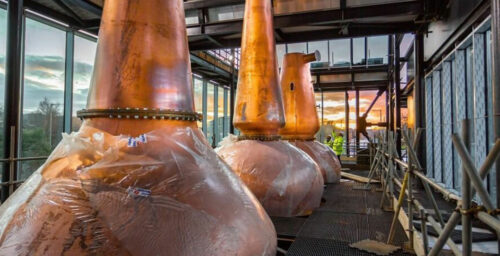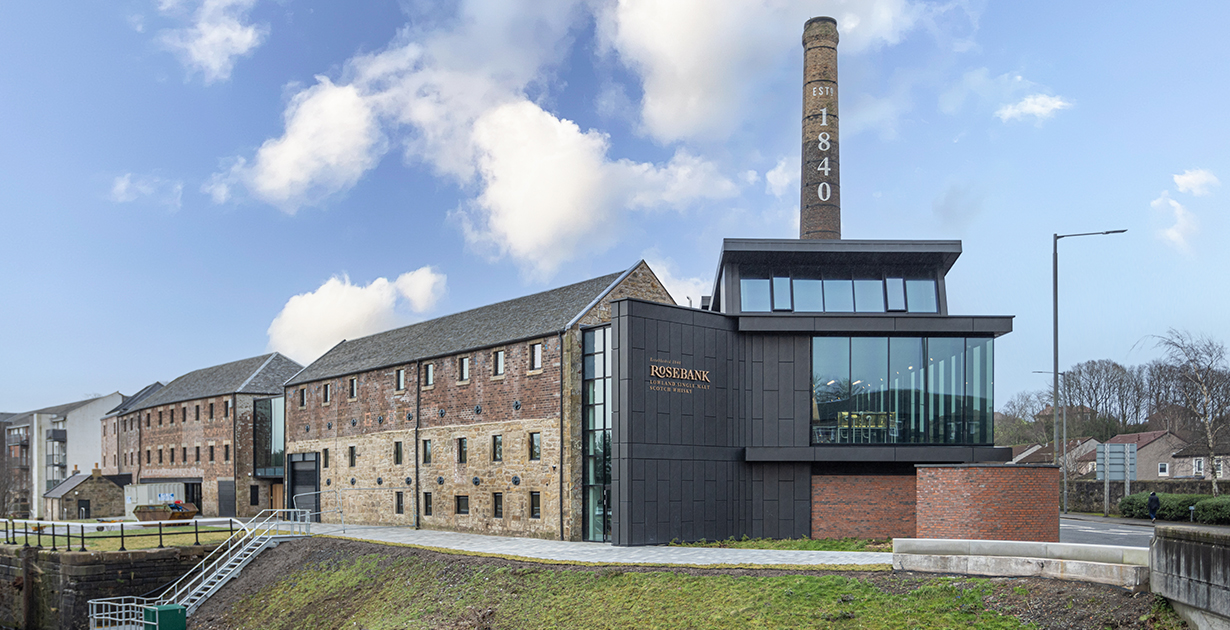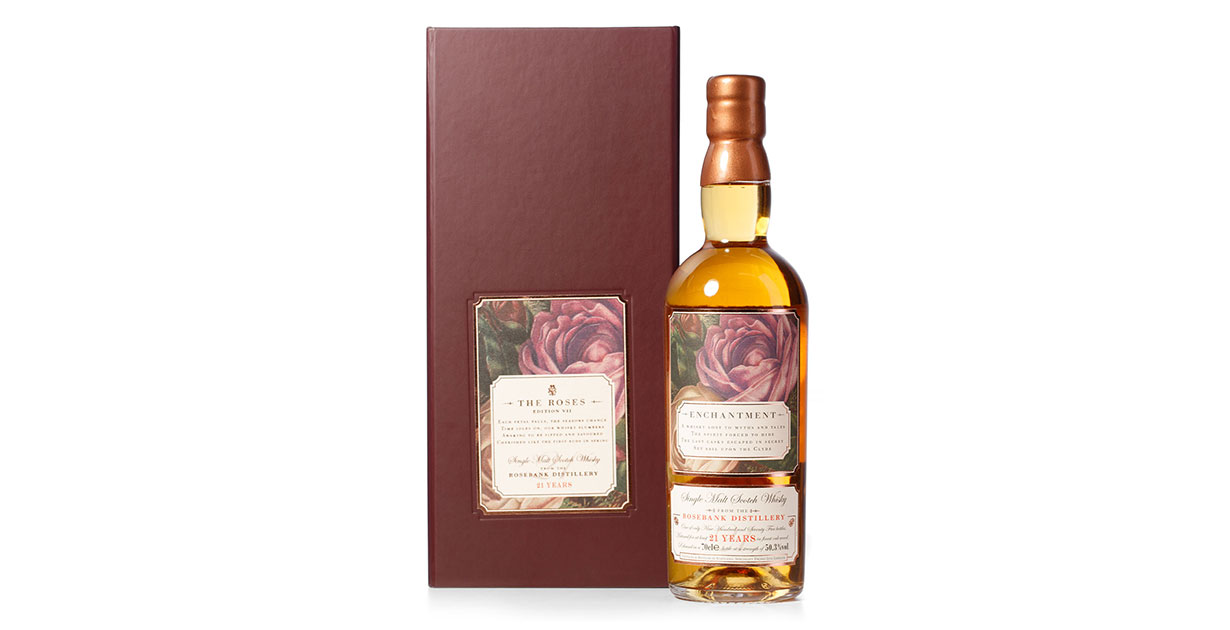
Rosebank Distillery was once considered the king of the Lowlands, with its gentle and palatable spirit building up a unique and dedicated following during its lifetime. In the years since its closure in 1993, Lowland-malt fans have sustained themselves on Rosebank’s rare official bottlings (including 8 year olds, 12 year olds, 15 year olds, and a 20 year old) and numerous independent bottlings.
As many whisky fans will already know, production recommenced in 2023, after 30 years of silence. However, there was a time, around Christmas 2008, when the uncertain future of Rosebank became shrouded in even more doubt, following a theft of the distillery’s original stills.
This is the fascinating story of Rosebank’s darkest hour and subsequent revival, bringing a new lease of life to Lowland single malts.
The Original Rosebank Distillery
The first record of distilling on the site of the Rosebank distillery dates back to 1798 when whisky distillation was allegedly carried out by the Stark family. The site is located on the bank of the Firth and Clyde Canal, around 27 miles west of Edinburgh.
Despite the assertions of early distilling, a distillery named Rosebank was not operational on the site until 1817. This distillery was operational for just two years. Then, in 1827, the Stark family went back to whisky-making at a distillery called Camelon, on the opposite bank of the canal to Rosebank.
This distillery, too, was relatively short-lived, and by 1840 James Rankine had built on the site of Camelon’s maltings a new distillery called Rosebank. In the ensuing years, this distillery bloomed. By 1861 the Camelon distillery buildings were demolished to make way for Rosebank’s own maltings.
During the whisky boom at the end of the 19th century, Rosebank grew in status and popularity. Demand amongst blenders was superbly high, so much so that sales were made by allocation.
By 1914, the distillery became one of the founding members of Scottish Malt Distillers (SMD). SMD was set up as a subsidiary of Distillers Company Limited (DCL) in order to bring some structure to the management of the Lowland distilleries in its portfolio. Other distilleries in SMD included Clydesdale, Glenkinchie, St Magdalene, and Grange. In 1925, SMD was folded into DCL following a series of mergers.
The Closure of The Distillery
The distillery’s fortunes began to change in the mid-20th century. The Firth and Clyde Canal was becoming obsolete, as trains and roads became the preferred routes for travel and trade. The canal was closed and suddenly it became extremely difficult to deliver supplies to Rosebank.
In 1988, one of Rosebank’s warehouses was sold for redevelopment and subsequently turned into a Beefeater Pub & Grill.
Then, in the same year, another blow was dealt to Rosebank when United Distillers (formally DCL) chose Glenkinchie to represent the Lowlands in its Classic Malts of Scotland series. Whilst many have argued that Rosebank is the definitive Lowland malt, it turned out to be much more economically viable for United Distillers to choose Glenkinchie.
Glenkinchie Distillery was in a stunning location, much more attractive to tourists than Rosebank, which sat in the middle of a town next to a closed (and stagnant) canal. In addition, Glenkinchie had a much larger output than Rosebank by more than four times.

Despite these setbacks, and the economic downturn experienced by the entire whisky industry, whisky fans remained hopeful that Rosebank would remain open due to its popularity amongst drinkers. Then, in 1993 the decision was made by then-owners United Distillers to close the distillery. This was due to reluctance on the part of United Distillers to spend the approximately £2 million needed to upgrade facilities such as the treatment plant in such turbulent economic times. Although Rosebank was closed three years into the 1990s, it would not be inaccurate to call the distillery a victim of the whisky loch.
And so, on June 30th, 1993, the distillery was closed. The stills fell silent and the gates were locked. In 2002, the site and buildings were sold to British Waterways. However, no further redevelopment took place. This led some Rosebank fans to hold out hope that the distillery would be reopened.
Then, over the Christmas period in 2008, all hopes of Rosebank’s revival were seemingly dashed, following a great theft.
The Theft of The Stills
Rosebank developed a dedicated following during its lifetime, with whisky critic Michael Jackson calling the whisky “the finest example of Lowland malt”. This was due to the distillery’s characteristically Lowland, and yet entirely unique style.
The whisky produced at Rosebank was subjected to triple distillation imparting a light, floral, and citrusy profile onto the whisky. By contrast, the worm tubs imparted a thick texture on the palate. The result was a perfectly balanced and gentle single malt that is mourned by many.
As such, it was the equipment at the distillery that made it possible to produce such high-quality and consistent whisky. So, when thieves made off with the original copper stills and mash tun from Rosebank in 2008, hearts were broken. The theft of the original equipment all but killed any hope of reviving Rosebank’s distinctive style of whisky.
Police at the time asserted that “[we] believe that a significant amount of planning would have been involved in order to get into the building, then set about removing the metal equipment over some weeks. The site is a historic listed building and, although it closed in 1993, is a landmark in the Falkirk area”. Nobody was ever arrested or charged with the crime.
Rosebank’s Revival

In 2017, Ian Macleod Distillers purchased the Rosebank Distillery site and buildings much to the shock and happiness of many distillery fans. Finally, a distilling company had purchased the distillery, and Rosebank was set to make a comeback.
To be able to produce the style of Rosebank whisky that was so loved and lamented by the distillery’s fans, Ian Macleod meticulously designed and built copper stills and a mash tun to the exact specifications of the old equipment. It was said that these new stills, exactly the same in every way as those that were stolen, would replicate the long-lamented Lowland style.
The stills were lowered into place, the distillery was renovated and eventually reopened. In 2023, spirit flowed from the stills of Rosebank for the first time in 30 years. The king of the Lowlands was back.
Welcome Back Rosebank
Since news of its reopening broke in 2017, Rosebank has released several limited edition single malts including a 30 Year Old, a 31 Year Old, two NAS whiskies from single casks, and a 1990 retail exclusive.
Then, in 2023, the stills were active once again. Of course, it will be a few years before we see any younger expressions come out of Rosebank. In the meantime, it will be interesting to see how the distillery uses its aged stocks to increase market presence and let Lowland malt fans know: that Rosebank is here to stay.
Shop Rosebank
Browse our selection of delicate Rosebank whiskies on The Whiskey Wash Shop, including this stunning Rosebank 21 Year Old “Enchantment”.









